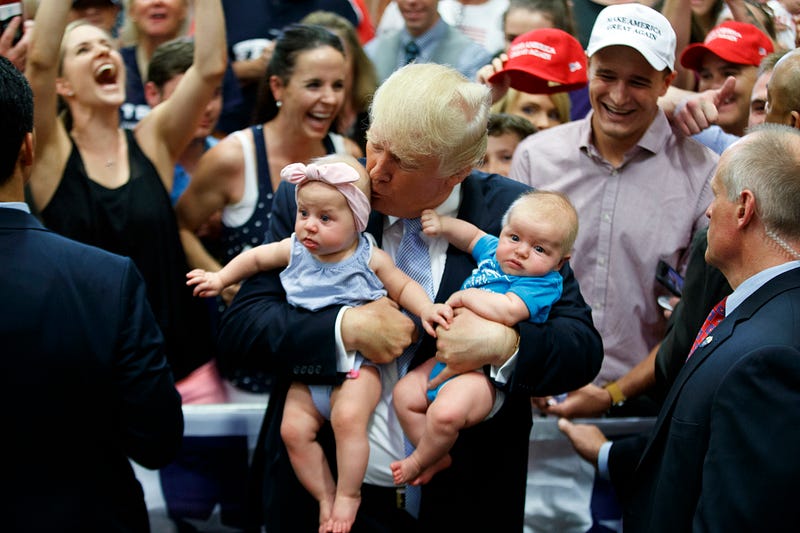Bryce Covert, ThingProgress, April 24
Wealthier families stand to benefit much, much more.

President Trump’s plan to make childcare more affordable for American families will barely help those of his supporters who need help the most, according to a new analysis.
On the campaign trail, Trump put forward a plan that he claimed would make the astronomical cost of childcare come back down to earth: allowing families to fully deduct what they spend up to a certain cap, while offering a “rebate” for lower-income families and tax-free savings accounts. Once in office, he promised he would be “fighting to make sure that all mothers, and all families, have access to affordable childcare.”
But the people most in need of help to afford quality care will get the least from his policy changes.
According to a new analysis by the Center for American Progress (CAP), for the typical family of four in the areas that swung most strongly in Trump’s favor in the recent election — those living in Appalachia, the Midwest, and northern Plains — his plan would yield just an extra $5.55 a year to cover the cost of childcare. These families make about $68,500 a year and spend about $6,000 on childcare — so five dollars isn’t likely to make much of a dent. (ThinkProgress is an editorially independent news site housed at the Center for American Progress.)
A lot of the voters who were more likely to vote Trump in 2016 than for Mitt Romney in 2012 live in rural and small towns in these areas. “They’re kind of middle class, just getting by,” said Rasheed Malik, policy analyst at CAP and co-author of the analysis.
Trump’s plan is structured in a way that will barely benefit them. With a tax deduction, “your benefit is higher the more money you make and the more you spend on childcare,” explained Katie Hamm, vice president of early childhood policy at CAP and the other co-author. But the swing counties that helped elect Trump were “more economically distressed,” she said, so “people have less income and they have therefore less to spend on childcare, so they’re penalized by both of those things.”
On top of that, Trump’s plan leaves current tax benefits like the Child and Dependent Care Tax Credit in place, which is worth up to $6,000. So any net payout of his tax code changes to families that make use of it will only accrue after it’s taken into account — hence such a small dollar amount in swing counties.
“You would have to really spend a lot on childcare up front to get any kind of significant net tax benefit,” Malik said
That means other, better off families who already spend much more on childcare will see a significantly bigger benefit from Trump’s plan. “Those tend to be found in cities and coastal areas, big metro areas,” Malik said.
The authors analyzed what the benefit would be for a well-to-do family of four living in the wealthy Manhattan neighborhood Trump used to call home before moving to the White House. Such a family typically earns about $295,000 a year and spends about $26,000 a year on childcare. Under Trump’s plan, that family would see an extra $7,329 net a year to cover the money spent on childcare.
Not only will lower-income families who supported Trump get less, but the structure of his policy will also make it even more useless to them. Because it doles out money through the tax code, families have to spend their own income on childcare throughout the year and then hope to reap any benefit of a tax refund in April.
“The mismatch in timing really leaves out a whole lot of families,” Malik said. “This assumes that everybody can already afford it and they just need a little bit of a discount on next year’s tax bill. But the families who can almost afford quality childcare are not going to be helped by this because you will essentially have to spend thousands upfront and wait until March or April of the following year to get your couple hundred dollars.”
“If you can’t afford childcare now, this doesn’t help you afford it,” Hamm added.
A wealthy family, on the other hand, likely has an easier time spending the money on childcare throughout the year and getting a tax deduction during tax time.
Trump’s plan also doesn’t do anything to address whether the childcare options parents have are high-quality or even available. A previous CAP analysis found that 40 percent of children live in what it dubbed childcare “deserts,” or zip codes with either no centers or more than three times as many children under the age of five as available spots.
The CAP analysis squares with other findings on Trump’s proposal. The Tax Policy Center recently crunched the numbers and found that families earning below $40,000 a year across the country would get a benefit of $20 or less. Those earning between $100,000 and $200,000 a year, on the other hand, would get about $360. In total, the center’s analysis found that more than 70 percent of all the benefits of Trump’s tax plan would accrue to those making more than $100,000.
The tax plan isn’t the only Trump policy likely to affect childcare. In his skinny budget outline released in March, he called to eliminate the 21st Century Community Learning Centers program, the only federal source of funding for afterschool programs. Without that money, many programs would have to shut down, leaving the low-income parents who rely on them for childcare before and after school hours in the lurch.


